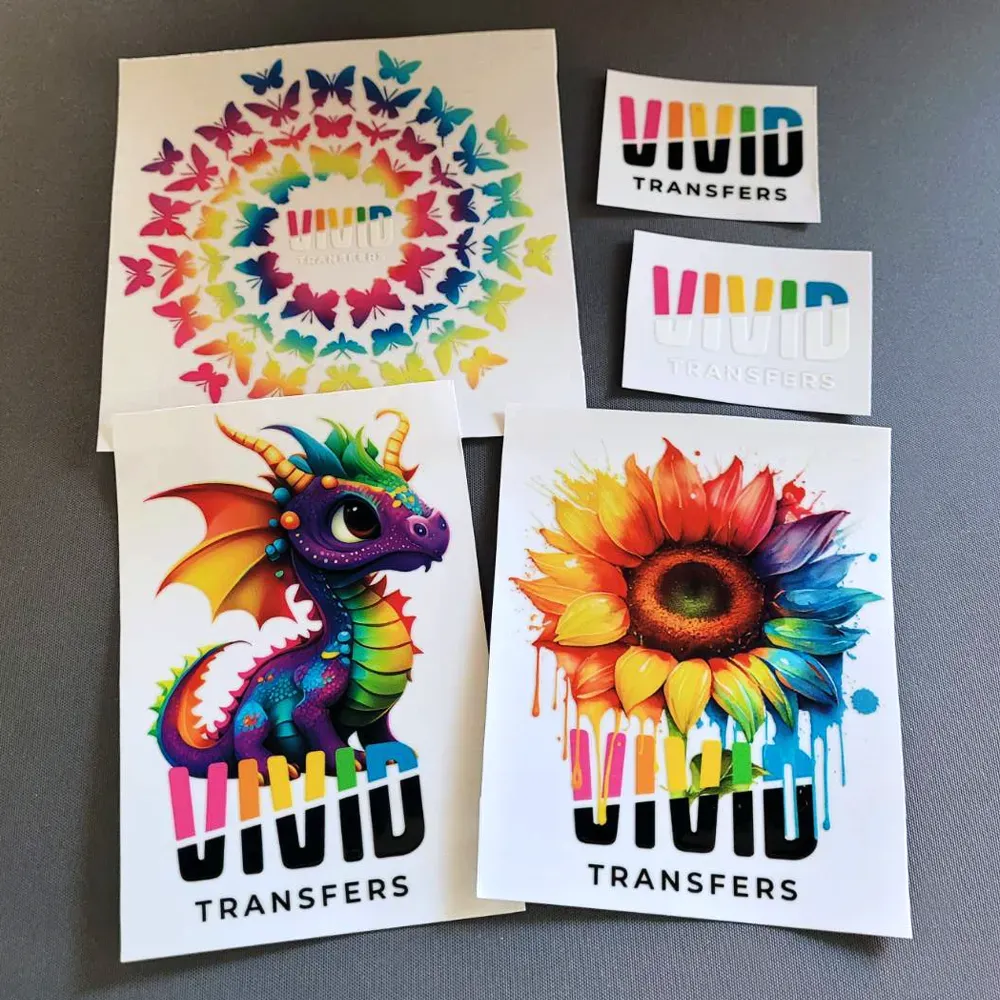UV DTF transfers are revolutionizing the printing landscape by marrying traditional UV printing technology with the convenience of Direct to Film (DTF) methods. This innovative approach allows for high-resolution prints on a multitude of surfaces, making it a game changer for custom apparel and promotional products. As businesses seek to maximize efficiency and quality, UV DTF transfers emerge as a frontrunner in the future of printing, appealing to both small startups and established corporations alike. Not only do these transfers provide stunning visual results, but they are also aligned with sustainable printing practices, minimizing waste and reducing environmental impact. By leveraging the capabilities of UV DTF technology, companies can meet the growing demand for personalized and eco-friendly products in a competitive market.
The concept of UV DTF transfers, or UV Direct to Film transfers, embodies a significant advancement in digital printing techniques. This method enables the creation of vibrant images that can be easily applied to various materials, including textiles and plastics, making it ideal for custom merchandise. As the landscape of the printing industry continues to evolve, it’s clear that the shift towards UV DTF technology reflects broader trends in sustainable printing and efficiency. More than just a printing solution, this technique resonates with businesses aiming to enhance their offerings while adhering to environmental standards. With the rise of UV DTF printing, the future of fast and customizable print solutions looks brighter than ever.
The Rising Popularity of UV DTF Transfers in Custom Apparel
In recent years, UV DTF transfers have gained significant traction in the custom apparel market. This innovative printing technology allows for vibrant and long-lasting designs, making it an ideal choice for brands looking to stand out in a competitive landscape. As the industry leans more towards on-demand production and personalization, UV DTF transfers meet the growing consumer demand for custom apparel without the lengthy turnaround times associated with traditional printing methods.
Moreover, the versatility of UV DTF transfers means that businesses can easily adapt to market trends and customer preferences. Whether it’s producing limited edition items or fulfilling unique requests, this printing method opens up new avenues for creativity and innovation. As more apparel brands adopt UV DTF technology, we can expect to see an increased emphasis on high-quality, custom designs that resonate with consumers.
Technological Advancements in UV Printing Technology
The advancements in UV printing technology are paving the way for more efficient UV DTF transfers. Major manufacturers are continually refining their processes, focusing on improving ink compositions for better adhesion and color vibrancy. High-resolution printing capabilities combined with rapid curing technologies ensure that businesses can produce high-quality prints at unprecedented speeds, which is critical in today’s fast-paced market.
These technological leaps not only enhance the quality of the prints but also allow for broader applications across various substrates. From apparel to promotional products, UV DTF technology is becoming synonymous with versatility in printing. As digital printing continues to evolve, businesses that leverage these innovations will be at the forefront, catering to a wider array of customer needs.
Sustainability in UV DTF Transfers and Its Impact
In an era where sustainability takes center stage, UV DTF transfers offer a more eco-friendly alternative to traditional printing practices. Unlike conventional methods that often rely on harmful chemicals and excessive water usage, UV DTF technology embraces an environmentally conscious approach by utilizing non-toxic inks and reducing waste. This alignment with sustainable printing practices not only helps in minimizing environmental impact but also appeals to an increasingly eco-aware consumer base.
By prioritizing sustainability in print production, companies can strengthen their brand image and appeal to customers who value eco-friendly initiatives. As the future of printing becomes more intertwined with environmental considerations, businesses adopting UV DTF transfers will not only contribute to a healthier planet but also gain competitive advantages in a market that is increasingly shifting towards sustainable solutions.
Exploring Market Growth and Opportunities for Businesses
The market for UV DTF printing is expected to experience significant growth, fueled by the rising demand for personalized and bespoke products. Projections estimate that the market could be worth $35 billion by 2028. This growth trajectory presents incredible opportunities for businesses looking to enter the custom printing space or expand their current offerings. As UV DTF technology becomes more accessible, savvy entrepreneurs can leverage this potential to cater to niche markets and personalized product demands.
With the growth of e-commerce and on-demand production, small and medium enterprises are particularly well-positioned to capitalize on UV DTF technology. The minimal setup costs and quick turnaround times associated with this printing method allow smaller businesses to compete effectively with larger market players, creating a dynamic environment ripe for innovation and creativity in product design.
Versatility of UV DTF Transfers Across Various Industries
One of the most remarkable features of UV DTF transfers is its unparalleled versatility. This technology can be applied to a range of substrates, from textiles and apparel to hard surfaces like wood and plastics. Such adaptability makes UV DTF the go-to choice for businesses operating in diverse industries, including fashion, promotional products, and even home decor. As consumer preferences evolve towards unique and customized items, the ability to produce high-quality prints across various materials provides a distinct competitive edge.
This versatility not only meets the customization demands of clients but also facilitates the ability to cater to emerging markets. Businesses that specialize in unique niches, such as personalized gifts and specialty items, can greatly benefit from incorporating UV DTF transfers into their production processes, thus expanding their customer base and enhancing their market presence.
Community Growth and Educational Resources for UV DTF Technology
The rise of UV DTF technology has sparked the development of a vibrant community dedicated to education and resource sharing. As industry professionals and enthusiasts gather through online forums, webinars, and workshops, they exchange valuable insights and best practices, fostering an environment of continuous learning. This collaborative spirit not only benefits individuals seeking to enhance their skills but also propels the overall advancement of UV DTF printing technology.
Through community efforts, users can troubleshoot challenges, explore new techniques, and innovate collectively in the field of UV DTF printing. As this community continues to grow, it will play a vital role in supporting the future of printing. Engaging with fellow professionals and accessing educational resources can empower print businesses to elevate their offerings and remain competitive in the ever-evolving market landscape.
Frequently Asked Questions
What are UV DTF transfers and how do they work in digital printing?
UV DTF transfers, or UV Direct to Film transfers, are a hybrid printing method that combines UV printing technology with the DTF process. This innovative technique allows for high-quality prints to be transferred onto various substrates by using a film intermediary. The UV printing process utilizes ultraviolet light to cure inks instantly, resulting in vibrant colors and durable graphics, making it an ideal solution for custom apparel and promotional products.
How does UV printing technology enhance the capabilities of UV DTF transfers?
UV printing technology significantly enhances UV DTF transfers by enabling quick curing of inks using ultraviolet light. This rapid curing method allows for detailed and vibrant images to be printed on numerous surfaces without the lengthy drying times associated with traditional ink. Thus, it addresses the demand for faster turnaround times in custom printing while maintaining high-quality results, positioning UV DTF printing as a forward-thinking method in the future of printing.
Are UV DTF transfers environmentally sustainable compared to traditional printing methods?
Yes, UV DTF transfers are considered more environmentally sustainable than traditional printing techniques. They typically consume less water and utilize non-toxic solvents, reducing harmful waste and emissions. As businesses increasingly focus on sustainable printing practices, adopting UV DTF technology not only lowers the environmental impact but also aligns with consumer preferences for eco-friendly products.
What type of materials can I use with UV DTF transfers for custom apparel?
UV DTF transfers are highly versatile and can be applied to a wide range of materials, including various fabrics used in custom apparel, such as cotton, polyester, and blends. Additionally, this printing method can also be used on non-fabric substrates like wood, plastics, and metals, enabling businesses to expand their product offerings and cater to niche markets effectively.
How is the growth of UV DTF printing affecting the future of digital printing?
The growth of UV DTF printing is revolutionizing the future of digital printing by providing businesses with efficient and high-quality solutions for product customization. The anticipated market expansion, projected to reach $35 billion by 2028, highlights the increasing demand for personalized products. As more companies adopt UV DTF technology, the printing landscape will see enhanced quality, innovation, and competitiveness, setting new standards for digital printing.
What educational resources are available for beginners looking to learn about UV DTF transfers?
For beginners interested in UV DTF transfers, a variety of educational resources are available, including webinars, workshops, and online forums. These platforms foster community engagement, allowing users to share insights and troubleshoot challenges. By participating in these educational opportunities, aspiring printers can enhance their skills in UV DTF technology, navigating the evolving landscape of digital printing with confidence.
| Key Points | Details |
|---|---|
| Introduction to UV DTF Transfers | Combines UV printing with DTF methods for high-quality prints on various substrates, promoting efficiency and sustainability. |
| Technology Advancements | Manufacturers are enhancing ink formulations and color-management systems, improving print quality. |
| Market Growth | Projected to reach $35 billion by 2028, driven by the demand for personalized products and accessibility for SMEs. |
| Sustainability Factors | Uses less water and avoids toxic solvents, making it an eco-friendly option compared to traditional printing methods. |
| Applications and Versatility | Can print on various materials including fabrics, wood, and plastic, suitable for short-run custom printing. |
| Educational Resources and Community Growth | Community of professionals sharing knowledge through webinars and workshops, boosting collective innovation. |
Summary
UV DTF transfers represent a transformative advancement in the printing industry, characterized by enhanced versatility and eco-friendliness. This innovative method merges UV printing with DTF techniques, resulting in high-quality prints that cater to diverse substrates. As businesses increasingly embrace UV DTF transfers, they benefit from faster production times, reduced environmental impact, and the ability to meet the growing consumer demand for personalized products. The commitment to sustainability and community knowledge sharing further positions UV DTF transfers as a vital player in the evolving landscape of printing technology.

